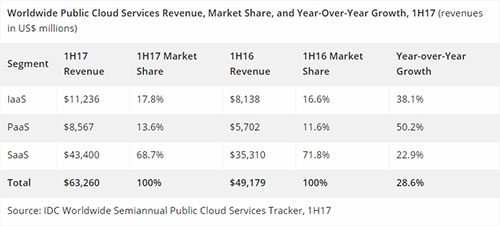Cloud Storage and Backup Benefits
Protecting your company’s data is critical. Cloud storage with automated backup is scalable, flexible and provides peace of mind. Cobalt Iron’s enterprise-grade backup and recovery solution is known for its hands-free automation and reliability, at a lower cost. Cloud backup that just works.
During the first half of 2017, public cloud providers generated $63.2 billion in sales, a year-over-year increase of over 28 percent. The leading segment, SaaS (software-as-a-service), was responsible for 68.7 percent of that haul, or $43.4 billion. In terms of growth, SaaS providers saw their fortunes rise by 22.9 percent on an annual basis as enterprises increasingly shift their business application workloads to the cloud.
Second-place IaaS (infrastructure-as-a-service) accounted for $11.2 billion of total revenue during the first half of the year and notched a 17.8-percent share of the market, a year-over-year gain of 38.1 percent.
IDC research director Deepak Mohan credited the brisk adoption rate to offerings like Microsoft Azure Stack and VMware Cloud on AWS that are making it easier for enterprises to implement hybrid IT models and adopt cloud solutions. “Cumulatively, these are paving the way for the next wave of enterprise application deployments on public cloud IaaS,” stated Mohan.
Although it represents the public cloud market’s smallest segment relative to SaaS and IaaS, PaaS is making impressive gains. The public cloud category achieved a year-over-year growth rate of just over 50 percent, with revenue of over $8.5 billion and a 13.6-percent market share.
PaaS vendors have application container platforms like Docker to thank for the surge in demand, at least in part.
“The rapid adoption of container technology in the PaaS segment has given developers additional tools to accelerate application development and deployment that is important in the enterprise digital transformation journey,” said Larry Carvalho, research manager at IDC’s PaaS practice, in a statement. “All vendors are modifying their solutions to bring automation into the entire application lifecycle, and developers are rewarding such vendors with higher than average gains.”
Most enterprises (67 percent) are using containers, at least in some manner, according to Cloud Foundry Foundation’s recent Global Perception Study. A quarter (25 percent) of the 540 enterprise developers surveyed for the report said their organizations were using containers in production.
And it’s only natural that IT budgets feel in the impact of the application containerization craze.
Earlier this year, a study container data services company Portworx discovered that spending on container solutions was on the rise. Nearly a third of enterprises (32 percent) polled for the study said they are expected to fork over $500,000 or more on container usage fees and licenses in 2017. A year ago, only five percent of respondents said the same.
Pedro Hernandez is a contributing editor at Datamation. Follow him on Twitter @ecoINSITE.



